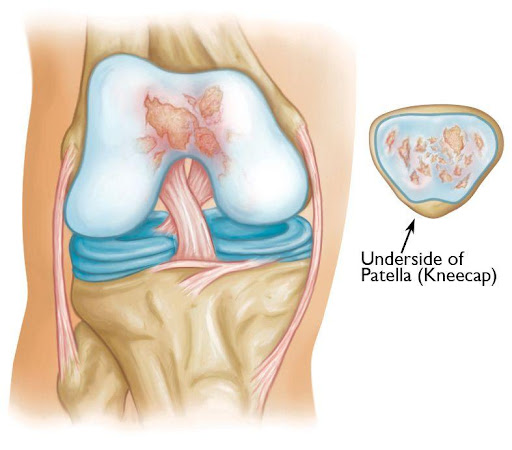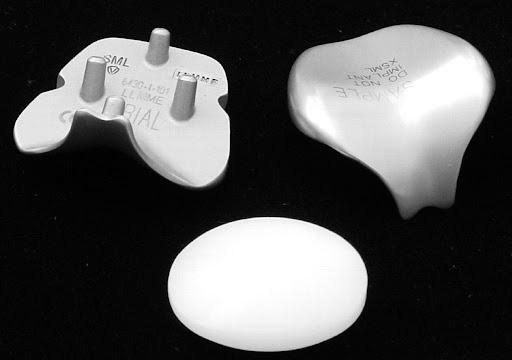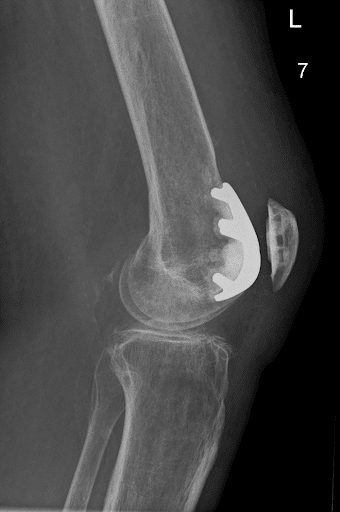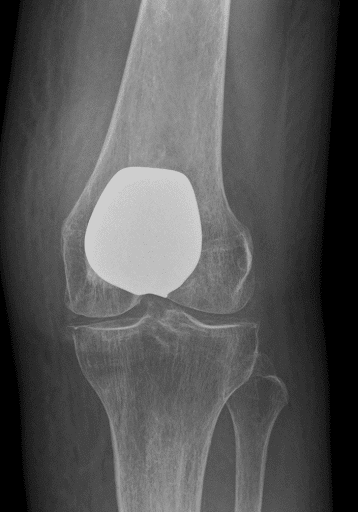Patello Femoral Joint Replacement (Kneecap Joint Replacement)
In knee osteoarthritis, the cartilage protecting the bones of the knee slowly wears away. As the cartilage wears away, it becomes frayed, and the underlying bone may become exposed. The exposed bone may be restricted to one part of the knee joint or the whole of the knee joint. Moving the bones along this rough surface is painful.
Patello Femoral Joint Knee replacement (PFJ replacement) is a type of partial knee replacement in which only a portion of the knee is resurfaced. This procedure is reserved for patients whose damaged bone and cartilage is limited to the underside of the patella (kneecap) and the trochlea (channel-like groove in the femur) on which patella articulates. This condition is called patellofemoral arthritis.
Because the surgery is done through a smaller incision, there is less damage to soft tissues in the knee which leads to faster recovery when compared to Total Knee replacement.
The other main advantage of PFJ replacement over total knee replacement is that because the ligaments of the knee joint are preserved, the prosthetic knee still retains the natural feeling of the native knee.
- Less blood loss
- Smaller surgical incision/less surgical trauma
- Less pain and swelling
- Quicker recovery
- Decreased complications
- Increased knee function and activity
In addition, because the bone, cartilage, and ligaments in the healthy parts of the knee are maintained, many patients report that a patellofemoral replacement feels more natural than a total knee replacement.
Disadvantages of Patellofemoral Replacement
The main disadvantage is that the rest of normal knee may develop arthritis in future which will need a revision to Total Knee replacement. For example, a total knee replacement may be necessary in the future if arthritis develops in the remaining parts of the knee that have not been replaced.
Illustration shows osteoarthritis that is limited to the patellofemoral compartment of the knee. The kneecap has been flipped to demonstrate the damage done to the cartilage.

Candidates for Surgery
If your osteoarthritis has advanced and nonsurgical treatment options are no longer relieving your symptoms, your doctor may recommend knee replacement surgery.
Careful patient selection is crucial when considering patellofemoral replacement. To be a candidate for the procedure, your arthritis must be confined to only the patellofemoral compartment of your knee.
In addition, if you have any of the following, you may not be a suitable candidate for the procedure:
- Knee stiffness
- Ligament damage
- Poor patellar (kneecap) tracking
- Major deformity of the leg
- Inflammatory arthritis (such as rheumatoid arthritis)
- Crystalline arthritis (such as gout)
- Morbid obesity
Orthopaedic Evaluation
You will be thoroughly evaluated by the consultant regarding your suitability for Avon Knee.
Medical History
Your doctor will ask you several questions about your general health, your knee pain, and your ability to function.
Location of pain. It is important for your doctor to determine the exact location of your pain. Candidates with pain in patello femoral joint usually present with anterior knee pain Patello femoral joint gets loaded more in bent knee position. They classically present with the following symptoms
- Pain while going up and down stairs while walking on even ground is fine
- Pain while walking on uneven ground
- Sitting with the knee bent/ getting up from a seated position like rising from a chair
Physical Exam
Your doctor will perform a thorough physical examination to determine the source of your pain. During the exam, they will:
- Inspect the leg to check for alignment problems
- Feel your knee to localise the site of pain originating from the knee
- Test range of motion to determine if you have knee stiffness or problems with patellar tracking (the kneecap shifts out of place as your leg bends or straightens)
- Assess the quality of the ligaments around the joint and the overall stability of your knee
Imaging Studies
- X-ray. X-rays provide images of dense structures, such as bone. Your doctor will order X-rays from several different angles to ensure that your arthritis is confined to the space between the kneecap and the femur, and to assess the overall alignment of your knee.
- Magnetic resonance imaging (MRI) scan. An MRI creates better images than an X-ray of the soft tissues in your knee. Your doctor may order an MRI to better evaluate the cartilage in your knee.
Your Surgery
This surgery can be done on a outpatient basis due to faster recovery after the surgery. During your initial consultation, your doctor will determine whether you are a candidate for outpatient surgery or will require a brief stay in the hospital.
Before Surgery
When you arrive for surgery, your surgeon will see you and verify the surgical site by signing the correct knee with a marker.
In addition, a doctor from the anaesthesia department will discuss anaesthesia choices with you. You should also have discussed anaesthesia choices with your surgeon during your preoperative visits. Anaesthesia options include General anaesthesia (you are put to sleep) or spinal anaesthesia (you are awake, but your body is numb from the waist down)
Surgical Procedure
Inspection of the joint. During surgery, the surgeon will inspect all the three compartments to ensure that the cartilage damage is restricted only to the patellofemoral joint. If not, then your surgeon will instead perform a total knee replacement. This will be discussed with you in detail during the time of initial consultation as well as during the consenting process.
Patellofemoral replacement. There are two parts to the procedure:
- Prepare the bone. Your surgeon will use special tools to remove damaged cartilage and a small amount of bone from the patellofemoral compartment of your knee.
- Position the implants. A plastic button, or cover, is used to resurface the backside of the patella. This button will line up with a thin metal component that is used to resurface the trochlear groove at the end of the femur. These parts are typically secured to the bone with cement (see picture below)
Side View of Avon Knee
Front view of Avon Knee
After Surgery
After surgery, you will be taken to the recovery room where you will be closely monitored as you recover from the anaesthesia. You will then be either taken to your hospital room or discharged (if your surgery is being performed on an outpatient basis).
Complications
As with any surgical procedure, there are risks associated with patellofemoral replacement. These risks are similar to those of total knee replacement. These risks will be discussed in detail during the consultation with the surgeon. Feel free to ask the surgeon any doubts you may have about the risks during the consultation.
The possible risks of patellofemoral replacement include:
- Infection and/or wound healing problems
- Blood clots – DVT (Deep Vein Thrombosis – leg clots) /PE (lung clots)
- Persistent pain
- Patellar instability (dislocating kneecap)
- Injury to surrounding structures, including blood vessels or nerves
- Reaction to anaesthesia
- The need for additional surgery
Recovery
Pain management – After surgery, you will feel some pain. Many types of medicines are available to help control pain, including opioids, nonsteroidal anti-inflammatory drugs (NSAIDs), and local anaesthetics. Treating pain with medications can help you feel more comfortable, which will help your body heal and recover from surgery faster.
Opioids can provide excellent pain relief; however, they are a narcotic and can be addictive. It is important to use opioids only as directed by your doctor and stop taking them as soon as your pain starts to improve.
Weightbearing. Full weight bearing is allowed immediately after the surgery. You might need crutches for the first few days to help with pain and balance.
Rehabilitation exercise. It is essential to keep the knee moving to get back the strength in the muscles. This is usually done under the guidance of physiotherapy. It is critical to perform these exercises as often as directed in order to achieve a good outcome.



